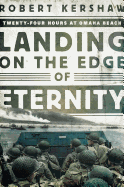
On the morning of June 6, 1944, American infantry landed at Plage d'Or on the coast of Normandy, an area designated Omaha Beach by Allied planners. It was just one of several amphibious assaults, paratrooper drops and air/naval bombardments that marked the D-Day invasion of Nazi-occupied France. But of the five major beach landings, Omaha was by far the worst.
On the German side, a mediocre garrison had been recently replaced by veteran troops, and these forces occupied formidable positions. Omaha Beach, at four miles long, was penned in on either end by sheer cliffs and along the center by steep bluffs. The only way off the beach, besides summiting those obstacles, was through five gaps, some with roads, leading inland to small villages. The Germans concentrated their defense on these passes. During the previous years of occupation, they had constructed huge concrete strongpoints with interlocking and flanking fields of fire. These, plus an obstacle belt in the surf, minefields and pre-sighted artillery, effectively stopped the first wave of American attackers.
In Landing on the Edge of Eternity, former paratrooper and current military historian Robert Kershaw gives a thrilling narrative of the longest day's most trying hours. He switches deftly between command and unit level on both sides, with glimpses of the destruction wrought on French civilians. Kershaw clarifies and expands an event made even more famous by Saving Private Ryan's opening scene, which accurately reflects the violence encountered by the first wave but simplifies the terrain and course of battle. This is a visceral account of apparent defeat, ultimate victory and how the United States Army sustained more than 2,400 casualties on a single beach in one day. --Tobias Mutter, freelance reviewer

